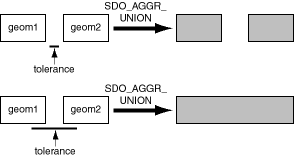1.10 Spatial Aggregate Functions
SQL has long had aggregate functions, which are used to aggregate the results of a SQL query.
The following example uses the SUM aggregate function to aggregate employee salaries by department:
SELECT SUM(salary), dept FROM employees GROUP BY dept;
Spatial aggregate functions aggregate the results of SQL queries involving geometry objects. Spatial aggregate functions return a geometry object of type SDO_GEOMETRY. For example, the following statement returns the minimum bounding rectangle of all geometries in a table (using the definitions and data from Simple Example: Inserting, Indexing, and Querying Spatial Data):
SELECT SDO_AGGR_MBR(shape) FROM cola_markets;
The following example returns the union of all geometries except cola_d:
SELECT SDO_AGGR_UNION(SDOAGGRTYPE(c.shape, 0.005)) FROM cola_markets c WHERE c.name <> 'cola_d';
For reference information about the spatial aggregate functions and examples of their use, see the Spatial Aggregate Functions reference chapter.
Note:
Spatial aggregate functions are supported for two-dimensional geometries only, except for SDO_AGGR_MBR, which is supported for both two-dimensional and three-dimensional geometries.
Parent topic: Spatial Concepts
1.10.1 SDOAGGRTYPE Object Type
Many spatial aggregate functions accept an input parameter of type SDOAGGRTYPE. Oracle Spatial defines the object type SDOAGGRTYPE as:
CREATE TYPE sdoaggrtype AS OBJECT ( geometry SDO_GEOMETRY, tolerance NUMBER);
Note:
Do not use SDOAGGRTYPE as the data type for a column in a table. Use this type only in calls to spatial aggregate functions.
The tolerance value in the SDOAGGRTYPE definition should be the same as the SDO_TOLERANCE value specified in the DIMINFO column in the xxx_SDO_GEOM_METADATA views for the geometries, unless you have a specific reason for wanting a different value. For more information about tolerance, see Tolerance; for information about the xxx_SDO_GEOM_METADATA views, see Geometry Metadata Views.
The tolerance value in the SDOAGGRTYPE definition can affect the result of a spatial aggregate function. Figure 1-8 shows a spatial aggregate union (SDO_AGGR_UNION) operation of two geometries using two different tolerance values: one smaller and one larger than the distance between the geometries.
Figure 1-8 Tolerance in an Aggregate Union Operation

Description of "Figure 1-8 Tolerance in an Aggregate Union Operation"
In the first aggregate union operation in Figure 1-8, where the tolerance is less than the distance between the rectangles, the result is a compound geometry consisting of two rectangles. In the second aggregate union operation, where the tolerance is greater than the distance between the rectangles, the result is a single geometry.
Parent topic: Spatial Aggregate Functions